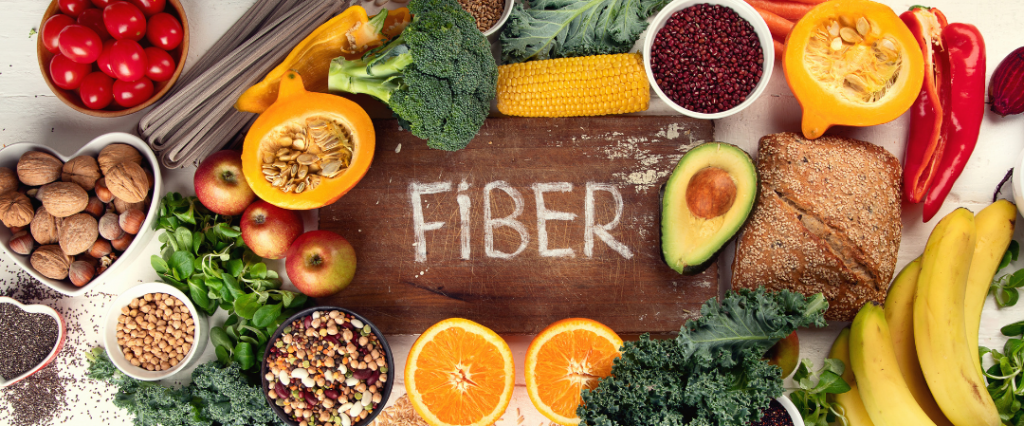By Deja Becknell, BSN
nutraMetrix Health & Nutrition Writer
You probably know fiber is good for you and can help get things moving, but do you really know why? Soluble and insoluble are the two main types of fiber. Both types of fiber do different, but equally valuable things for our body, let’s break it down.

What is Fiber?
Dietary fiber is a type of carbohydrate found in plant foods (which include vegetables, fruits, whole grains, legumes, seeds, and nuts) that cannot be digested or absorbed by the body. Instead, fiber slows digestion as it moves through the body, helping to make your stools easier to pass. Unlike simple carbohydrates, such as certain types of bread, processed foods and sugars, fiber is a complex carbohydrate.
Soluble Fiber
Soluble fiber can be found in many plant-based foods you’re a fan of. As soluble fiber passes through your gut, it pulls in water and partially dissolves, forming a thick gel which helps to give the stool volume and slow down digestion. Slowing down digestion puts the brakes on the rate at which carbohydrates enter into the bloodstream, helping to prevent spikes in blood sugar after eating. For example, if you drink a glass of apple juice; the sugar will be absorbed by the body very quickly, causing your blood sugar to climb. On the other hand, if you eat a whole apple (which contains fiber) this level raises more gradually. Eventually, most soluble fibers reach the large intestine and become fermented by bacteria. This fermentation helps to produce nutrients and feed the good bacteria in your gut, improving gastrointestinal health.
Insoluble Fiber
You guessed it; insoluble fiber is just the opposite from its sibling. Insoluble fiber does not dissolve in water to form a gel. This means that it stays in its bulky form as it travels through the body, helping to push food along and bulk up the stool. This can make food in the stomach and intestines softer and easier to pass with less strain on your bowel, which helps to prevent and relieve constipation. Since insoluble fiber is not digested at all by the body, it’s not a source of calories or glucose, meaning both soluble and insoluble fiber can help manage blood sugar levels
Insoluble fiber can be found in foods such as:
-whole grains (such as brown rice, wheat bran, couscous)
-root vegetables (such as carrots, parsnips and potatoes)
-cauliflower
-celery
-fruits with edible seeds
-nuts
Hydration is Essential
One of the most common diet shortfalls is water and fiber. Water is essential for healthy digestion and the proper activity of fiber. The food we eat travels from our stomach to the large intestine, or colon. If you’re not properly hydrated, the large intestine has to soak up water from your food waste. This is often the culprit behind hard stools that are difficult to pass. Dehydration means your body is losing more fluids than it’s taking in. Drinking too little water during exercise, hot weather, or daily activities can cause your body to use up its stored water. Other bad habits that contribute to water loss can include excess coffee consumption, processed, high sodium foods and alcohol. Fiber isn’t as effective if you’re not properly hydrated. It can also be helpful to meet your needs by consuming fruits like watermelon, oranges, as these all help add to your hydration load.
How Much Fiber Should I Aim For?
Fiber is an essential nutrient, which means it must be eaten in the diet. According to the Academy of Nutrition and Dietetics, only 5% of Americans get enough dietary fiber. You might be wondering; well how much do I need?
If you feel like your digestion is off, the right foods can help. Dietary fiber increases the weight and size of your stool. If you experience loose or watery stools, fiber can help solidify and add bulk to it. An added benefit is high-fiber foods also tend to be more filling than low-fiber foods, meaning you’re less likely to grab a second plate.
Dietary intake is dependent on a number of factors including age, health concerns and physical activity. It’s recommended to include a mixture of both soluble and insoluble fiber in your diet. Most experts say you should let your body be your guide. In general, for the average person, 21-35 grams of total fiber per day is a good goal. If you experience bowel-related problems, you should try increasing your water intake and adjusting the fiber in your diet to your comfort. Increasing your fiber intake too fast can cause gastrointestinal upset, so make sure to increase the amount you eat gradually.
Both soluble and insoluble fiber have numerous digestive health benefits that can help increase feelings of fullness after a meal. Fiber is essential to a healthy diet and can be a helpful aid in weight management, blood sugar regulation, lipid levels and more. The numerous benefits give fiber a powerful advantage against concerns associated with sluggish or irregular bowel movements. Since one type isn’t better for you than the other, it’s important to include both in your diet for optimal digestion and overall health.
Article Sources:
Khatri, M. (2020, January 25). Water, Constipation, Dehydration, and Other Fluids. WebMD. https://www.webmd.com/digestive-disorders/water-a-fluid-way-to-manage-constipation.
Olsen, N. (2018, March 1). Soluble vs. Insoluble Fiber: What’s the Difference? Healthline. https://www.healthline.com/health/soluble-vs-insoluble-fiber#benefits
Phillips, M., & Zieve, D. Soluble and insoluble fiber: MedlinePlus Medical Encyclopedia Image. MedlinePlus. https://medlineplus.gov/ency/imagepages/19531.htm
Publishing, H. H. Rethinking fiber and hydration can lead to better colon health. Harvard Health. https://www.health.harvard.edu/diseases-and-conditions/rethinking-fiber-and-hydration-can-lead-to-better-colon-health.
